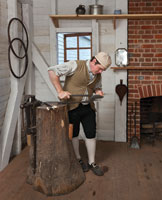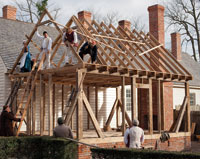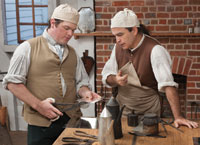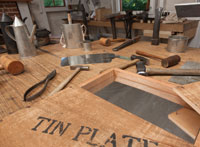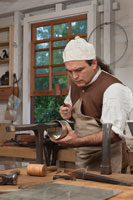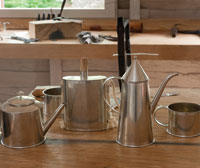Online Extras
Tinsmith Slideshow

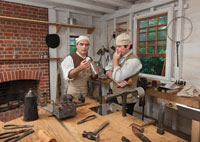
Dave Doody
Steve Delisle, left, and Joel Anderson in the reconstructed Tin Shop, a part of the expanded Anderson Public Armoury
Meet the Tinmen
by Ed Crews
Sitting side by side in Colonial Williamsburg’s Historic Area, the Tin Shop and blacksmith’s forge are a study in contrasts. The blacksmiths labor in a world of fire and smoke, the whoosh of bellows, the clang of hammers, and the sizzle of hot metal plunged into water. Next door, tinman Steve Delisle creates cups and kettles, and softer sounds the squeak of shears cutting sheet metal, the tap of a hammer, and the muffled thump of a mallet. As Delisle says: “The din of tin is nowhere near as loud as the blacksmith’s trade.”
The reconstructed Tin Shop is Colonial Williamsburg’s newest trade, and its first tinsmithing operation since the restoration of the colonial capital began in 1927. Part of Anderson’s Blacksmith Shop and Public Armoury, the Tin Shop helps to show that Williamsburg was an eighteenth-century arsenal of the American cause. Gifts from Forrest E. Mars Jr., the retired chief executive of Mars Incorporated, made the complex possible.
Like blacksmiths and gunsmiths at the gritty Anderson industrial site, Delisle works on military gear, replicating tasks done at the shop during the War for Independence. For him, that means producing such things as canteens, cups, kettles, saucers, lanterns, and speaking trumpets.
Delisle and apprentice Joel Anderson interpret their craft during the period 1778–80, a time when, perhaps, three or more men toiled at the shop. “One man may have traced patterns onto sheets of metal and cut out the parts. Another craftsman could have shaped these into components and done some basic assembly, while a third person would do the final assembly and soldering,” Delisle said.
These workers probably learned their trade through a seven-year apprenticeship started at age fifteen. During their training, they mastered the craft’s basic skills–cutting, shaping, and assembling and its tools, including mallets, hammers, vises, files, pliers, punches, specialized anvils, and shaping forms. They also honed their math skills, aesthetic sensitivity, and ability to do precision work.
According to Delisle, the trickiest task they’d learn was soldering: “In the eighteenth-century, tinmen usually joined seams by soldering. They used an iron soldering rod with a copper head that was placed in a charcoal brazier. An artisan making a cup would bend a piece of metal to form its cylinder and then would put the ends together to form a smooth, watertight seam.”
“A tin-alloy solder was placed on it. In the seconds before the copper head cooled after leaving the fire, the tinman had to solder the seam shut. He had to work quickly, relying on the right rhythm and steady hands,” Delisle said. A one-time tool and die maker from Quebec, he has studied the eighteenth-century trade closely through classes, research, and self-education.
These artisans did not work with sheets of tin. Tinware was fashioned from thin sheets of iron coated with molten tin, which provided a rust-resistant veneer. These sheets were about 10 inches by 13-3⁄4 inches and were worked cold, because shaping required no heat. In the eighteenth-century tin workers sometimes were called “tinmen,” though the term tinsmith, too, was used.
During the revolution, the military wanted tin items, because they were inexpensive, lightweight, and durable. These qualities explain tin’s use for such civilian goods as funnels, colanders, basins, pastry molds, teapots, graters, convection ovens, lanterns, snuff boxes, and needle cases.
The tinware the American navy and army needed wasn’t easy to get. Until the war, most tin items came from England. Relatively few tinmen lived in the colonies, and supplies of raw material were limited by the British blockade. It’s easy to understand why Williamsburg armorer James Anderson needed tin workers and how important they were to his operation and the Continental Army. Delisle and Anderson make those points with visitors. They also are busy producing tinware to display in the shop and for use by other Williamsburg trades.
Delisle wants to bring attention to the eighteenth-century tin trade through symposia and social media, and the shop may create a program to help youngsters sharpen their math skills.
“We have a great opportunity to teach children geometry,” he said. “Tin items can be used to explain ideas about volume and everyday use of geometric formulas. We easily could show students how you can take a sheet of metal and use it to make a three- dimensional object. We really have the potential here to do a whole lot.”
Ed Crews, a Richmond, Virginia-based journalist, wrote the journal’s eighteenth-century occupations series, updated here with Colonial Williamsburg’s addition to Historic Trades interpretations.

